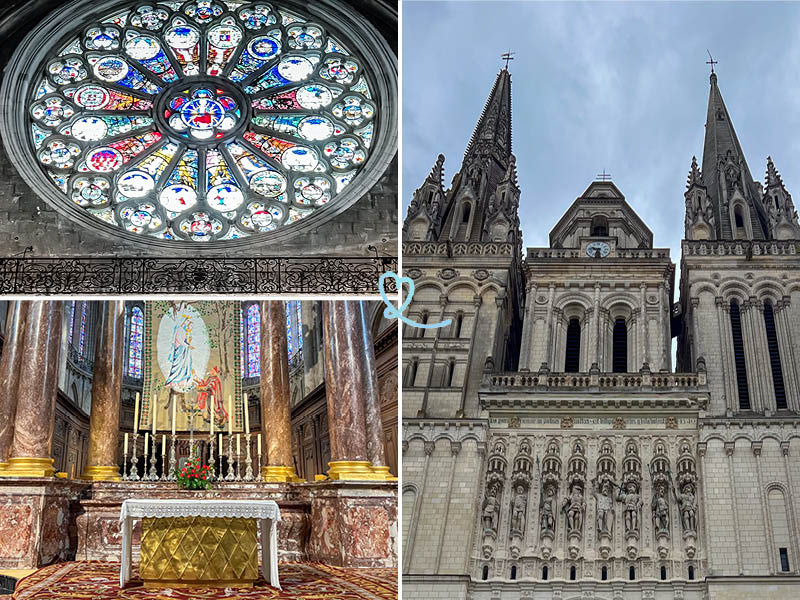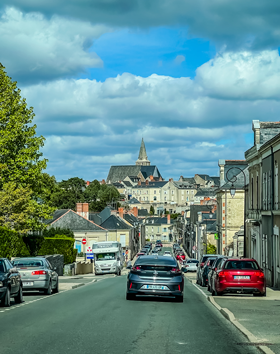Planning a stopover in Angers? Be sure to visit Saint-Maurice Cathedral!
Dominating the city, the building is one of the symbols of the capital of Maine-et-Loire. As the royal necropolis of the princes of Anjou, the monument has had an eventful history and today houses a historical treasure trove, which you'll discover in this article. A cradle of Anjou's Gothic style, it is also a true architectural masterpiece.
In this article, you'll find some useful tips to help you prepare for your visit and have a wonderful time!

This guide is completely independent, based on our experiences. We visited the region anonymously, making our own choices and paying our bills in full.
Why visit Angers Cathedral?
Is Saint-Maurice Cathedral worth it? Our opinion:
Yes, we're convinced that the cathedral is well worth a visit! Built on a hill and linked to the Maine by magnificent staircases, it is one of Angers' most beautiful monuments. You'll be captivated by the magnificence of its western façade and colorful stained glass windows.
The building is distinguished by its heterogeneous architecture, a cross between Gothic and Romanesque. Tried and tested by history, it has undergone many reconstructions and modifications, which today add a touch of mystery to the site.
The cathedral also houses an exceptional treasure. One of the richest in France!
It's one of the best attractions in Angers.

What's the cathedral famous for?
Angers Cathedral owes part of its fame to its treasure. We were amazed by its richness! Comprising a fabulous collection of tapestries, including the famous Tenture de l'Apocalypse, it contains over 3,000 marvels: goldsmith's and silversmith's pieces, rich furniture, an urn and an exceptional bathtub.
The monument is also famous for inaugurating the Anjou Gothic style and inspiring numerous buildings in the region. A variation on classical Gothic architecture, this style is distinguished by its vaulted ceilings, which we were able to appreciate on our visit to the cathedral.
The cathedral housed the tombs of the last dukes of Anjou, key figures in the region's history. Visit "Good King René", the last Duke of Anjou, King of Sicily and Count of Provence, who introduced Italian Renaissance art to his lands, was buried here.
Finally, in 2024, Angers Cathedral will be the site of a bold architectural renovation. Japan's famous architect, Kengo Kuma, will build a monumental gallery in front of the building's entrance. We can't wait to admire these contemporary feats!

Our favorite moments
During the tour, Angers Cathedral reveals its attractions both inside and out. Here's what we liked best:
- the main façade and its gallery of figures: we were captivated not only by its height, but also by the finesse of the gallery's sculptures.
- the high altar: enthroned majestically in the transept, the altar is enhanced by a splendid Baroque baldachin.
- the stained glass windows: the fruit of a magnificent glass artist's work, the colorful stained glass windows play with the light, coloring the cathedral with magic. We were very touched by this poetry!

WHERE TO STAY IN Angers
Our favorites: neighborhoods and hotels
Downtown, to enjoy the city, its restaurants and beautiful architecture.
Hôtel L'Oisellerie - see photos and availability
Hotel 21, Foch - prices, pictures and availability
In the surrounding countryside, for greater peace and quiet
Hotel Château des Forges - see photos and availability

History in brief
With its rich and eventful history, Saint-Maurice Cathedral has stood the test of time and continues to amaze us today.
- Antiquity: The history of Angers Cathedral begins in the 4th century. It was then a religious monument of "Juliomagus" ("Julius's market", the ancient Roman name of the town). Dedicated to Saint-Maurice, it was burnt down by the Franks in the 5th century.
- Middle Ages: In the 11th century, Bishop Hubert de Vendôme built a full-fledged Romanesque cathedral on the foundations of the old sanctuary. Consecrated in 1025, it was ravaged by another fire in 1032. Reconstruction of the cathedral slowly resumed, extending into the 12th century under the impetus of several bishops, including Guillaume de Beaumont and Ulger. The monumental portal was designed at this time and the single nave rebuilt. It was inspired by those of Angoulême Cathedral and Fontevraud Abbey. The first segmental vaults were built around 1150. They mark the beginning of Angevin Gothic, also known as Plantagenet Gothic.

- Renaissance: In the 16th century, the square turret and hexagonal bell tower were added to the base of the two towers, along with the two spires. At the same time, a gallery of figures decorated the portal, depicting knights, the companions of Saint-Maurice.
- Contemporary period: In 1793, during the revolution, the monument became the Temple of Reason. He emerged relatively unscathed from this period of turmoil. In 1806, the monumental porch in front of the façade was demolished due to its age. The four imposing pointed arches still bear witness to the former entrance. In 1831, struck by lightning, the steeple caught fire and the cathedral burned down again. A protected heritage site, the building was listed as a Monument Historique in 1862. Restored in the second half of the 19th century, it suffered further damage following the 1944 bombardments. Gradually rehabilitated, it is gradually regaining its splendor thanks to the restoration work that continues to be carried out.
- The year 2024 will see the cathedral dressed in modernity: Japanese architect Kengo Kuma has designed a colossal porch, boldly reinventing the building's entrance.

How to get there: Cathédrale Saint-Maurice, Angers
Where is Saint-Maurice Cathedral?
- in downtown Angers
- at 4 rue Saint-Christophe
- at the summit of the magnificent Montée Saint-Maurice
- between Place Sainte-Croix and the Bishops' Palace
- near Château d'Angers
OUR TIPS FOR RENTING A CAR IN Loire
- Compare prices on our preferred platform: DiscoverCars - one of the best rated sites.
- Choose a fairly compact car (many villages have narrowed the road).
- Think aboutfull insurance (parking in big cities is really tight).
- There is a lot of demand, book it early.

How to get there?
The cathedral can be reached by bus. From the train station, take line 2 to the Sainte-Croix stop. You can also decide to walk there and explore the city center. The train station is a 13-minute walk from the monument. Expect a slight rise.
To plan your itinerary, we recommend you visit the official Angers public transport website here.

Parking
The cathedral does not have its own parking lot. But you can park in the adjacent streets. Please note that parking in the city center is not free. At weekends and in summer, places are also scarcer.
As the hourly rate is relatively expensive, you can opt for one of the other parking lots available in the city. The Ralliement parking lot is 300 meters from the cathedral. The first hour is free! This is also the case in 8 other downtown underground parking lots (Bressigny, Haras, Larrey, Leclerc, Mail, Mitterrand, Molière, République). For more information, visit the official Angers website here.
For free parking, visit the La Rochefoucaud parking lot, which offers 1,200 free spaces. It's a 15-minute walk from the cathedral on the other side of the river.
DISCOVER Angers
- Things to do in Angers
- Where to sleep in Angers: best hotels
- Where to eat in Angers: best restaurants
- Rent a car in Angers
- Visit the Château d'Angers
- Visit the Museum of Fine Arts in Angers - coming soon
- Château de Brissac
- Terra Botanica
- Best castles around Angers
- Most beautiful villages around Angers

Useful tips: duration, schedules, eating...
Best time to visit
The cathedral doesn't usually attract large crowds of visitors. At any time of year, you can enjoy a quiet visit at your own pace. However, we recommend that you avoid times dedicated to religious ceremonies. Masses are held at 9am and 7pm, depending on the day. Here you can consult the timetable for services and other celebrations.
Length of visit and main difficulties
Allow between 15 and 45 minutes to discover the cathedral, its history, architecture and treasures. We didn't notice any special facilities for people with reduced mobility, but the site nevertheless seems accessible.

Advice on how to visit
There's no set way to visit Angers Cathedral. We chose to start by admiring the western façade, with its finely decorated gallery and two towers crowned with stone spires. Afterwards, we recommend a tour of the building. You can discover the building's rich architectural heritage and the different constructions that have been built over the years.
Back on the forecourt, pass through the imposing portal into the nave . Take time to look at the chapels and contemplate the sumptuous canopied central altar. The organ and its 3 keyboards are also worth a look.
Above all, don't forget to look up to appreciate the domed vaults characteristic of the Anjou Gothic style. Finally, let yourself be guided by the shimmering colors of the stained glass windows and their play of light.

A LITTLE MORE patience
All the photos, maps, information, good addresses to make your stay in the Loire Valley a success, will soon be gathered in a single ebook!
If you wish to be informed of the publication of our guide on the Loire, register:

Schedules and rates
The cathedral is open every day from 8am to 8pm, except Tuesdays (6:45pm) and Saturdays (7pm). Admission and tours are free.
Guided tours
During the summer months, in July and August, you can enjoy free guided tours. They take place every day at 3pm and last about an hour.
Saturday afternoons are also available during the rest of the year.
Take a look at the official website of the Angers tourist office. Contact at the bottom of this page or on the cathedral website here.

Catering
Angers city center is bursting with friendly, tasty restaurants!
- Right next to the cathedral on Place Freppel, La Ferme restaurant offers elegant, high-quality dishes. Fresh seasonal produce and local wines on the menu!
- Venture a little further downtown and discover the gourmet restaurant Les Petits Prés. Why not indulge in the tasting menus of their innovative cuisine?
- Your taste buds will also be charmed by the delicate dishes of the Sens restaurant. Cross the Maine River and step through the doors of this establishment to enjoy authentic cuisine that will play with your senses!
Like us, you are gourmets? Let yourself be seduced by our selection by consulting our article on the city's best restaurants.

Architecture challenged by history
At the crossroads of several architectural styles
The cathedral's eventful history has shaped its architecture, and continues to do so! Today, the monument is a blend of Romanesque and Gothic. We were captivated by these architectural features.
Built on Romanesque remains, the building's foundations are imbued with this influence. You can sense these origins right from the forecourt, but also as you walk around the buildings. The base of the walls retains the sobriety of the Romanesque style up to mid-height, while the richness of Gothic art fills out the façade with sculptures and pointed arches. The two spires added in the 16th century belong to the Renaissance style and give the cathedral a more modern touch.

As you enter the cathedral, you discover the unique nave, rebuilt from the original Romanesque walls. Looking up, we admired the Gothic columns and sculptures, as well as the unique vaulted ceilings. Particularly domed, they rise to more than 24 meters and bear witness to the boldness of 12th-century architects. The cathedral was the site of the first experiments with this type of vaulting, giving rise to the Anjou Gothic style.

For the cathedral, 2024 will be a year of modernity. As part of the restoration of the monument, architect Kengo Kuma was commissioned by the French Ministry of Culture to design an immense stone gallery on the square in front of Place Monseigneur Chapoullie. Known for his monumental creations, the Japanese artist has designed three colossal, particularly graphic gates to enlarge the entrance. Shaking up the medieval architecture, this renovation will renew the look of the building, a true alliance of the ancient and the contemporary. We can't wait to admire the new cathedral!
The western facade
Complex and imposing, the western façade immediately caught our attention. They didn't leave us indifferent!
Built around 1150, the portal, surrounded by crown statues, is crowned by a tympanum with polychrome decoration that is still visible. This is the carved section just above the doors, whose painted decorations have survived the ages. These sculptures depicting a scene from the Apocalypse still retain a few colorful traces of their former splendor. Another witness to the past, the wooden door features 12th-century iron hinges. We weren't able to admire these details as the facade is currently being renovated.
Work began in 2022 and is scheduled for completion in 2024, with the aim of preserving the spandrel. The innovative construction of the colossal gallery, designed by Kengo Kuma, will protect and enhance the entrance.

Above the portal, dating from 1537, the gallery of figures is another eye-catcher. Sculpted with finesse and intricate detail, the representations of Saint-Maurice and seven knights sublimate the facade while paying tribute to these brave men. Legend has it that in the 3rd century, Maurice and his companions were put to death by the Emperor Maximian for refusing to perform a pagan ceremony. Sanctified, Saint-Maurice became the patron saint of Angers cathedral in the late 4th century.
On top of the sculptures, a prayer for peace invites us to meditate.

The towers
Rising majestically to the sky, three towers crown the cathedral. Starting with the two rectangular towers, the eye is carried away by the richly decorated spires. Rising to a height of 75 metres, the two finely chiselled octagonal structures are awe-inspiring. The turret at the center of the façade also caught our eye. Topped by a dome with lantern and the Anjou cross (a cross with two crossbars), its massive silhouette links the other two towers and seems to give the pediment its final touch.

Hidden behind the high windows, the cathedral's bells call out to visitors as the hours pass. We were lucky enough to hear them trumpet! The monument houses 9 bells. The largest, the Maurice bell, named in honor of the saint, weighs over 6 tons!
The art of sculpture and stained glass
A wealth of stained glass
With over 30 stained glass windows, Angers Cathedral is a magnificent example of French glass painting. Retracing the lives of Christ and the Saints, the stained glass windows transported us into the midst of medieval religious narratives, and their play of light enveloped our visit in magic.
We were particularly struck by the two superb rose windows dominating the ends of the transept. Created in 1452 by master glassmaker André Rodin, they dazzle with their colors and the finesse of their compositions. Depicting God in majesty, the signs of the zodiac and the elders of the Apocalypse, the south rose window bears witness to the artistic vitality of Anjou at the time.

Blown out by a bomb in 1944, the stained glass windows in the entrance on the right of the nave were reinvented in the 20th century by Jacques le Chevallier, another talented glassmaker. You can contemplate these contemporary creations and discover two representations of Saint-Maurille, the 5th century bishop of Angers, of the Good King René, the last Duke of Anjou and King of Sicily, as well as biblical scenes.
Despite the vicissitudes of history, the cathedral still boasts numerous stained glass windows dating back to the 12th and 13th centuries. In particular, we were mesmerized by one of the first stained glass windows to the left of the nave, at the entrance, and admired the colors and details of Mary crowned with Jesus.

The furniture
The cathedral's rich furnishings reflect the art of sculpture in many different forms. Dazzled by the splendid high altar, we were equally impressed by the solemnity of the organ.

The 18th-century high altar with its baldachin is a real eye-catcher! Occupying a central position, they pay sumptuous homage to Christ. Resting on two marble columns, the 15-meter high baldachin haloed the prophet with gilded wooden rays and scrolls. Let yourself be seduced by the baroque splendor of this masterpiece. A little anecdote: this baldachin was inspired by the one in St. Peter's Basilica in Rome and the church of Notre-Dame du Val-de-Grâce in Paris! During our visit, we also discovered two other altars: the one in the north arm of the transept, dedicated to the Virgin, and the one in the south arm, dedicated to Saint-Maurice.

Overlooking the entrance with its majesty, the great organ contributes to the cathedral's beauty. Badly damaged during the bombardments of 1944, it has now been restored to its former glory, with its three keyboards and countless pipes. We admired its magnificent Louis XV-style carved sideboard and the large statues supporting it. Facing the monumental instrument, a sculpture of Sainte-Cécile by the famous sculptor David d'Angers sits in the choir at the other end of the building. The patron saint of musicians reminds us of the importance of sacred music to the cathedral.

Episcopal tombs
Walking through the interior of the cathedral, we contemplated the various bishops' tombs. While some of them date from the 19th century, others date from the 12th. Such is the case with the tomb of Bishop Ulger, one of the driving forces behind the cathedral's reconstruction at the time. You'll be amazed to discover that the tomb retains its superb 12th-century wooden facing, still partly lined with copper strips decorated with brown varnish. From the same period, we also saw in the nave the funeral niche of the Bishop of Beaumont, another figure who left his mark on the cathedral's history.

The treasures of Angers' Cathédrale Saint-Maurice
The chapels
During your visit, be sure to admire the cathedral's chapels. The monument has three of them. One of them hides wonders!
The Chapelle Saint-Jean bears witness to the activity of a former cloister destroyed during the French Revolution. To the south, the Chapelle Notre-Dame de Pitié once served as a parish church. Finally, to the left of the entrance, our favorite, the Chapelle Sainte-Anne is perhaps the most interesting, as it now houses the cathedral's treasury. Also known as the Treasure Room, it can be visited on certain Saturdays! Check the tourist office website here for tour dates.

With over 3,000 items, this is a remarkable treasure trove! Some of these objects were donated to the Cathedral by Good King René, the last Duke of Anjou and King of Sicily, in the 16th century. Such is the case with a red porphyry urn, wrongly claimed to be the famous Vase of Cana, the vessel that is said to have contained the water Christ turned into wine. The Duke also brought a Roman bathtub in green marble, supported by white lion cubs, which was long used as a stoup. Other precious objects complete the treasure trove: precious bishops' crosses, a silver statue of Saint-Louis, another of Saint-Maurice, richly decorated goldsmith's crosses and a sumptuous collection of tapestries.
The Apocalypse Hanging
Angers Cathedral's treasure trove includes one of the world's largest tapestries, in an exceptional state of preservation: the Apocalypse Tapestry. More than 100 metres long, the most important medieval tapestry will captivate you with its magnificence!

However, this treasure cannot be viewed inside the cathedral. You'll have to go to the Château d'Angers to admire this astonishing tapestry. Entrusted by the cathedral, the monumental piece is displayed in the castle's specially-created gallery, the Musée de la Tapisserie de l'Apocalypse.
Read our article on the Château d'Angers to learn more about this masterpiece!
The murals
In the Middle Ages, the walls and vaults of Saint-Maurice Cathedral were covered with painted decorations. Unfortunately, most of them were whitewashed in the 17th century and stripped in the 19th.
What a surprise whena 13th-century painted decoration was rediscovered in 1980! Spared by time and reconstruction, it was miraculously preserved. Representing the life of Saint-Maurille, it features painted scenes on a red and green background. Today, this painting cycle is one of the most important 13th-century paintings in France. However, you won't have the chance to admire these paintings. Today, they remain hidden by the choir's wood panelling.

Subscribe to our Newsletter
- Get away from it all with Region Lovers' beautiful destinations!
- Once a month
- Advertising-free
Frequently asked questions
What's the link between Kengo Kuma and Angers' Cathédrale Saint-Maurice?
Kengo Kuma is a famous Japanese architect based between Tokyo and Paris. Renowned for his colossal, geometric constructions, he led major projects in France and Japan. For example, he led the construction of Tokyo's Olympic stadium in 2019. An enthusiast of the dialogue between heritage and innovation, he is currently in charge of two major projects in France: the extension of the Musée Albert Kahn in Paris and the creation of a monumental gallery on the portal of Angers Cathedral. To find out more , visit the French Ministry of Culture website.
When can you see Angers Cathedral illuminated?
For Christmas, Angers is decked out in lights. Saint-Maurice Cathedral also takes part in the festivities. Every year, the town organizes a sound and light show that brings the monument's western facade to life. Magic and enchantment are the order of the day!
To find out about possible screening dates, visit the tourist office website here.
What tourist attractions are nearby?
Near the cathedral and in the surrounding area of Angers, you'll find many tourist attractions, including museums and monuments.
- The Château d'Angers: explore the majestic 13th-century fortress, the city's landmark, and climb its towers for a breathtaking 360° view of the city. Read our dedicated article.
- Musée Jean Lurçat: explore this emblematic example of Anjou's Gothic style, featuring Jean Lurçat's contemporary Le Chant du Monde tapestry, an echo of the Apocalypse Tapestry. Read the dedicated article here! (coming soon)
- Galerie David D'Angers: the Abbatiale Toussaint exhibits works by sculptor David d'Angers. Discover sculptures, casts and sketches in a splendid setting.
- The Musée des Beaux-Arts: housed in the hôtel particulier du logis Barrault, this museum traces the history of the city of Angers and exhibits works from the 14th to the 21st centuries over more than 3,000m2.
Would you like to explore the Anjou region and discover the most beautiful towns along the Loire? Read this article!

Are there any interesting anecdotes about the Cathedral?
The stairs leading up to the hill on which the Cathedral stands have only recently been added. In the past, an old dirt road provided access to the site. The creation of these steps greatly facilitated the lives of local residents, while providing the monument with a worthy ascent.
A mysterious legend surrounds Angers Cathedral. The ghost of a parish priest still celebrates mass some evenings, condemned never to ascend to heaven. Could the fires that ravaged the monument have given rise to this darkest of stories?
What are the Mass times?
The Cathedral regularly hosts masses:
- weekdays, depending on the day: 9 a.m. and 7 p.m.
- Saturday and Sunday: 11 a.m. and 6:30 p.m.
Check the days and times of celebrations on the Diocèse d'Angers website here.
PLAN YOUR TRIP IN
Loire Valley
The castles of the Loire Valley

Other places to explore







